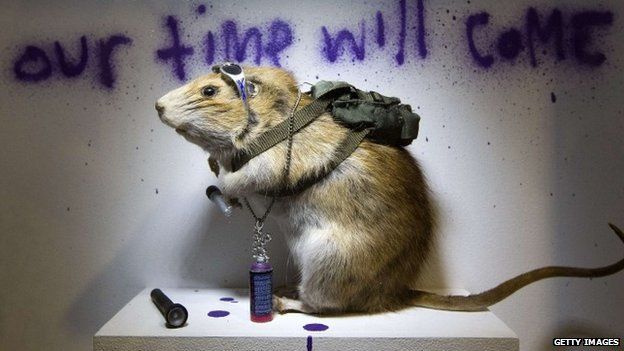Banksy's gets mainstream showing off at Sotheby's
- Published

Few know the real identity of street artist Banksy, who has turned protecting his identity an artform in itself.
The Bristolian's semi-mythical status has seen prices for his works skyrocket, his biggest pieces topping £1m at auction.
His rare large-scale shows are staged events in warehouses, rather than staid gallery spaces, but now a former associate has taken it upon himself to put on an unauthorised retrospective in the rather more sedate surroundings of Sotheby's S2 gallery in London.
Steve Lazarides, who worked with Banksy as his first art dealer up until 2008, has brought together 70 authenticated, career-spanning pieces for an exhibition and sale.
Some of the art has never been seen in public, having gone straight in to private ownership, and Sotheby's is hoping Banksy's fans will flock to see the free show - alongside the big spenders.
For those with deep pockets, the most expensive pieces for sale in the show come with a price tag of £500,000, which means someone, somewhere is making a hefty profit.
Among the works on offer are early canvases that came in editions of 25 and were sold for between £50 and £250. As Banksy has become more notorious, they have gone up and up in value.
"For the people who had paid £50 for them, as soon as they got to £1,500 they exchanged it, because it was a life changing amount of money to them," says Lazarides.
"And then it went to £5,000 so all the people who had paid £1,500 thought all their Christmases had come at once. And that went on for a few years until it got to the £50,000 mark and if you've got £50,000 to spend on a painting you probably don't need to sell it."
Banksy started out as a graffiti artist on the streets of Bristol, before moving into creating canvases for the commercial market.
"A lot of the questions in the old days were 'is it not a weird juxtaposition that a street artist is making canvases'," says Lazarides.
"But the point is, if these guys can't make things and sell things, the only people that can be street artists are the children of the rich and famous."
Much of Banksy's meteoric rise came from a series of high-profile stunts, such as surreptitiously placing his works in established galleries and museums - including Tate Britain.
"He did a whole series of interventions in museums," recalls Lazarides. "I think his theory was 'if they are not going to show my work then I'm going to put it in myself'."
Banksus Militus Vandalus, a rat with a spray can in a glass box, was briefly nailed to the wall of the Natural History Museum to look like one of the exhibits.
It is one of the pricier pieces in the retrospective, with a price tag in excess of £500,000, although Sotheby's is keeping quiet about the actual sums involved in the sale.
None of the works are Banksy's trademark graffiti pieces that have been removed from walls or buildings.
"The show being here at Sotheby's is almost a validation of the whole scene,'' says Lazarides.
"When we were doing this 15 years ago, everyone told us this was impossible, no one would buy the work, no-one would pay the prices, no-one would take it seriously, it wouldn't pass the test of time. Yet here we are 15 years later."
Another of the show pieces in the exhibition is Avon and Somerset Constabulary (2001).
"Avon and Somerset Constabulary goes to the core of his [Banksy's] anonymity," says Lazarides.
"When I was growing up in Bristol in the 80s I was friends with a lot of graffiti artists. Even then, Avon and Somerset Constabulary had a very draconian policy towards graffiti happening.
"Banksy was prolific in Bristol and I think this whole thing with the anonymity was self-preservation rather than self-promotion."
The charismatic Lazarides calls himself an "accidental art dealer" who helped Banksy "make his vision happen".
The pair parted ways more than six years ago, and Lazarides is slightly cagey about the reasons.
"We just moved apart. A decade is a long time to be working alongside someone hand in glove. And I like working with lots of new artists and giving them a hand at the beginning.
"It's very difficult to represent a whole group of artists when you have one artist that you have such an intense relationship with."
Although they no longer speak, Lazarides refuses to divulge any details about Banksy's appearance or his personality.
But he is honest enough to admit Banksy would not approve of this exhibition.
"He'd hate it. He's never done an exhibition in a gallery, never done one in my gallery - even when when we working together.
"When he puts shows on it's been an event rather than an exhibition, the whole thing is an performance piece. This is just not something he would do."
But, adds Lazarides: "I think someone will eventually do a retrospective, at least I have a love of his work, I know him and I've made sure the I've put stuff in that covers his whole career."
Banksy: The Unauthorised Retrospective runs at Sotheby's S2 gallery from 11 June to 25 July.
- Published8 May 2014
- Published8 May 2014